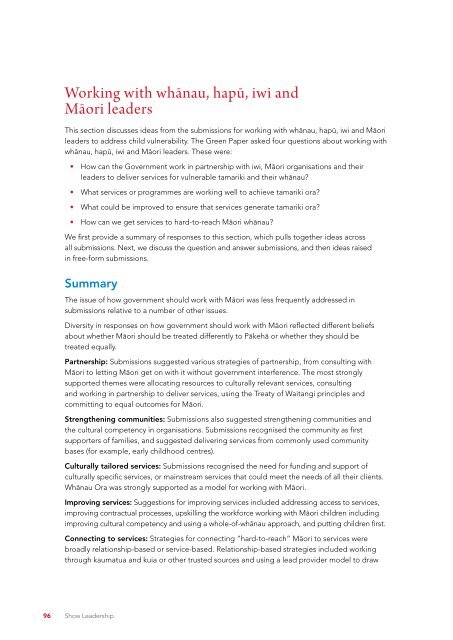The Green Paper for Vulnerable Children - Ministry of Social ...
The Green Paper for Vulnerable Children - Ministry of Social ...
The Green Paper for Vulnerable Children - Ministry of Social ...
You also want an ePaper? Increase the reach of your titles
YUMPU automatically turns print PDFs into web optimized ePapers that Google loves.
Working with whānau, hapū, iwi andMāori leadersThis section discusses ideas from the submissions <strong>for</strong> working with whānau, hapū, iwi and Māorileaders to address child vulnerability. <strong>The</strong> <strong>Green</strong> <strong>Paper</strong> asked four questions about working withwhānau, hapū, iwi and Māori leaders. <strong>The</strong>se were:• How can the Government work in partnership with iwi, Māori organisations and theirleaders to deliver services <strong>for</strong> vulnerable tamariki and their whānau?• What services or programmes are working well to achieve tamariki ora?• What could be improved to ensure that services generate tamariki ora?• How can we get services to hard-to-reach Māori whānau?We first provide a summary <strong>of</strong> responses to this section, which pulls together ideas acrossall submissions. Next, we discuss the question and answer submissions, and then ideas raisedin free-<strong>for</strong>m submissions.Summary<strong>The</strong> issue <strong>of</strong> how government should work with Māori was less frequently addressed insubmissions relative to a number <strong>of</strong> other issues.Diversity in responses on how government should work with Māori reflected different beliefsabout whether Māori should be treated differently to Pākehā or whether they should betreated equally.Partnership: Submissions suggested various strategies <strong>of</strong> partnership, from consulting withMāori to letting Māori get on with it without government interference. <strong>The</strong> most stronglysupported themes were allocating resources to culturally relevant services, consultingand working in partnership to deliver services, using the Treaty <strong>of</strong> Waitangi principles andcommitting to equal outcomes <strong>for</strong> Māori.Strengthening communities: Submissions also suggested strengthening communities andthe cultural competency in organisations. Submissions recognised the community as firstsupporters <strong>of</strong> families, and suggested delivering services from commonly used communitybases (<strong>for</strong> example, early childhood centres).Culturally tailored services: Submissions recognised the need <strong>for</strong> funding and support <strong>of</strong>culturally specific services, or mainstream services that could meet the needs <strong>of</strong> all their clients.Whānau Ora was strongly supported as a model <strong>for</strong> working with Māori.Improving services: Suggestions <strong>for</strong> improving services included addressing access to services,improving contractual processes, upskilling the work<strong>for</strong>ce working with Māori children includingimproving cultural competency and using a whole-<strong>of</strong>-whānau approach, and putting children first.Connecting to services: Strategies <strong>for</strong> connecting “hard-to-reach” Māori to services werebroadly relationship-based or service-based. Relationship-based strategies included workingthrough kaumatua and kuia or other trusted sources and using a lead provider model to draw96 Show Leadership
















